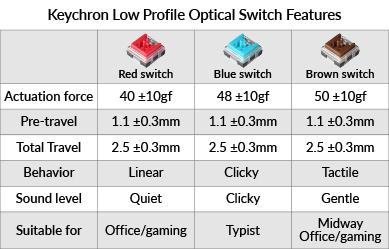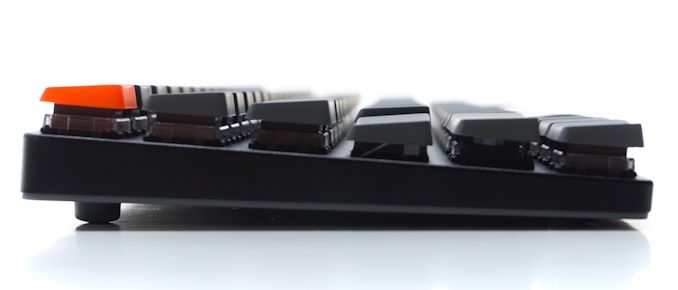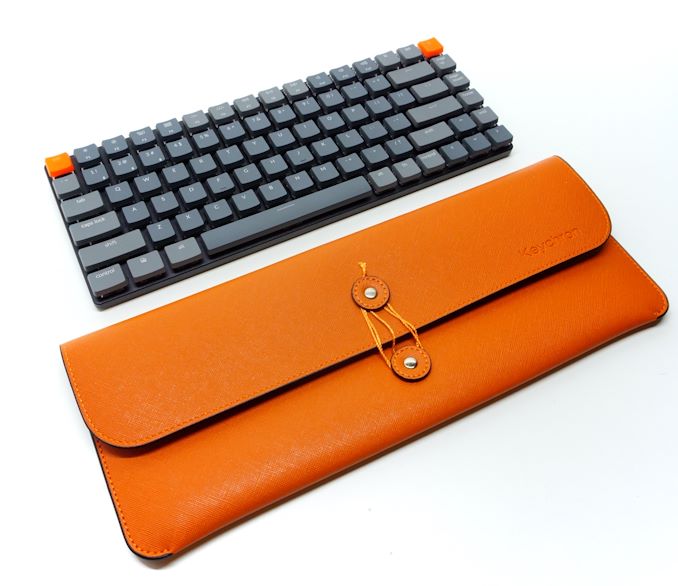The Keychron K3 Low Profile Wireless Mechanical Keyboard Review
by E. Fylladitakis on July 13, 2021 9:00 AM ESTPer-Key Quality Testing
In order to test the quality and consistency of a keyboard, we are using a texture analyser that is programmed to measure and display the actuation force of the standard keyboard keys. By measuring the actuation force of every key, the quality and consistency of the keyboard can be quantified. It can also reveal design issues, such as the larger keys being far softer to press than the main keys of the keyboard. The actuation force is measured in Centinewton (cN). Some companies use another figure, gram-force (gf). The conversion formula is 1 cN = 1.02 gf (i.e. they are about the same). A high-quality keyboard should be as consistent as possible, with an average actuation force as near to the manufacturer's specs as possible and a disparity of less than ±10%. Greater differences are likely to be perceptible by users. It is worth noting that there is typically variance among keyboards, although most keyboard companies will try and maintain consistency - as with other reviews, we're testing our sample only.
Keychron lists the following specifications for its switches. Our unit has the brown versions.
The machine we use for our testing is accurate enough to provide readings with a resolution of 0.1 cN. For wider keys (e.g. Enter, Space Bar, etc.), the measurement is taking place at the center of the key, right above the switch. Note that large keys generally have a lower actuation force even if the actuation point is at the dead center of the key. This is natural, as the size and weight of the keycap reduce the required actuation force. For this reason, we do display the force required to actuate every key but we only use the results of the typically sized keys for our consistency calculations. Still, very low figures on medium-sized keys, such as the Shift and Enter keys reveal design issues and can easily be perceptible by the user.
At first glance, the Keychron K3 appears to be somewhat inconsistent. This is due to the minor tolerances of the optical sensors that the switches are using. As the travel distance is very short, even small actuation point differences translate to large differences in force. The average actuation force is 53 cN, which seems high for Brown-type switches, but it actually is not (as with the table above, Keychron quotes 50 +/- 10). Again, due to the very short travel distance, the resistance of the springs must be higher, or the keys will feel extremely spongy and easily bottom down.
Hands-on Testing
I always try to use every keyboard that we review as my personal keyboard for at least a week. My typical weekly usage includes a lot of typing (about 100-150 pages), a few hours of gaming, and some casual usage, such as internet browsing and messaging. I personally prefer Cherry MX Brown or similar (tactile) switches for such tasks. As I frequently use a laptop, the 75% layout of the Keychron K3 was not an issue for me. Users who only or mainly use 100% keyboards will definitely have to take a short learning curve.
Not only the size but also the extremely low height and travel make the Keychron K3 feeling more like a laptop keyboard than a mechanical keyboard. Regardless, the typing experience is exceptional. The keyboard is very responsive and the feeling of each keypress is fantastic, with very little fatigue even after using it for several hours straight. Its stock Brown switches feel fantastic and are relatively quiet, making the Keychron K3 ideal for productivity in public places. Only in very quiet places, such as small libraries, the use of this keyboard would be annoying to other people in the immediate area.
For gaming, the Keychron K3 does not offer any advanced features other than its very low-profile and short travel switches. Theoretically, the shorter travel distance would cut a few milliseconds off someone’s reaction time. However, any difference is minuscule and has zero real-world meaning. If anything, the lag of the Bluetooth transmitter is much greater than any advantage the shorter travel could ever offer. The zero gap between the top rows also is not ideal for FPS/Action games. It is not a bad keyboard for gaming though, as it is very responsive and exceptionally comfortable. As long as the user is content with the 75% layout and doesn’t seek advanced features, the Keychron K3 will not disappoint.
The battery life of the Keychron K3, with the keyboard used solely for productivity, was roughly 80 hours with the backlighting turned off. That is not bad at all but was lower than the advertised 99 hours. In the manufacturer’s defense, my typical workday can be brutal for any keyboard. Turning the backlighting on and maxed out, the battery life dropped down to about 30 hours, close to the manufacturer’s 34-hour specification.
Conclusion
At first sight, the Keychron K3 feels as if it is more of a fashion item rather than a proper mechanical keyboard, with our initial thoughts being that the company is trying to put too many eggs into one basket. However, the K3 actually is a surprisingly good mechanical keyboard for those that need to combine mobility and productivity with a tiny bit of fanciness for under $100.
The quality of the Keychron K3 is very good, especially considering the price range and the features of the keyboard. Although the design is relatively simple, the materials are great and the assembly job is exceptional. Furthermore, even if a switch gets damaged, a whole pack of switches is just $19 and they are easily replaceable, which bodes great for those who like keeping their devices around for as long as possible. It is also worthwhile to mention that the company was very quick to listen to feedback, redesigned the rear cover and added rear feet to the retail version of the keyboard. This is a very rare choice for any company to make, as the vast majority of designs are never altered up to their end-of-life, signifying that Keychron actually cares about having the best possible version of a product in circulation.
In terms of aesthetics, the Keychron K3 is a little bit all over the place. It is designed to be very thin and elegant, matching a clean, modern desktop. The orange keycaps stand out too much in such an environment but, fortunately, the company includes normal grey keycap replacements for these. The RGB backlighting also is a little extravagant for visually calm and quiet environments but could work under certain circumstances.
The hands-on performance of the Keychron K3 is unexpectedly good, especially for a keyboard with such a short key travel. It is amazingly comfortable and feels great, even after hours of typing. However, it has few advanced features and virtually zero programmability, which will dishearten advanced gamers and coders alike. The 75% layout greatly reduces the footprint of the keyboard and makes it ideal for 14” or larger laptop bags but also requires a learning curve if one is not used to working with such layouts.
Keychron designed the K3 mainly with mobility in mind, for users who need a high-quality keyboard that fits in their bag. Although its battery life cannot compete with electronic keyboards designed for maximum mobility, it is long enough to get most users through a regular business trip or short vacation, especially when the backlighting is turned off. If there is no compartment in your bag just for the keyboard though, it would be wise to purchase the travel pouch offered by Keychron, or another similar pouch, as the keycaps will easily come off if the keyboard is not secured well.
The Keychron K3 is listed on the company website for $84 with the RGB backlights, or $74 with the white backlight.














41 Comments
View All Comments
brockhold - Tuesday, July 13, 2021 - link
Based on the photos of the controller, I believe this is nearly the same internally as the Royal Kludge branded combo USB+Bluetooth keyboards. Looks nice.kkilobyte - Wednesday, July 14, 2021 - link
Wake me up when they offer something else than the US-ANSI layout.Tyler_Durden_83 - Wednesday, July 14, 2021 - link
When they do, wake me up too :-)Lord of the Bored - Wednesday, July 14, 2021 - link
I mean, THIS isn't an ANSI layout.It isn't a GOOD layout, but it isn't ANSI.
kkilobyte - Wednesday, July 14, 2021 - link
That's actually how Keychron itself describes the layout on its own website (on the K3 firmware upgrade page).This is clearly a design that takes the main characteristics of the US-ANSI standard: large left shift key (ISO has two keys there), "Alt" key on the right of the spacebar (instead of Alt Gr.), "small horizontal" Enter key. Even though *strictly speaking*, the position of the cursor keys don't make it an exact ANSI layout.
But that was not my main point. What was is that the only available language layout is English/US, so that's actually useless in many countries.
Moreover, many non-US layouts are based on ISO, not ANSI, so it is not possible to simply replace the keycaps to adapt to a non-US language.
C@mM! - Wednesday, July 14, 2021 - link
Been using one as my work keyboard for a few months, its pretty good. Only issue I have is the USB light shines thru the keycap above it.Hoping for a 96% layout in the low profile, that'd be perfect for me personally for home usage where I play a few games that require a keypad but I hate full size keyboards for ergonomic reasons.
zepi - Wednesday, July 14, 2021 - link
I wish they did ISO-layout as well.isthisavailable - Wednesday, July 14, 2021 - link
Does this support n key rollover?Frazombie - Thursday, July 15, 2021 - link
Useful timing of the article, I've been keeping my eye on Keychron for a while. Like some of the above comments, the key thing stopping me hitting buy is the lack of ISO/UK layouts, particularly on their low profile options like the K3 (which would be my first pick) - please pay attention Keychron! ;)One other thing this article raises - you mention 'advanced' and gaming features... I'd like an article exploring that! Just how genuinely useful/impactful are some of those features? Or are they just marketing hype? Anti Ghosting, NKRO, Macros, etc - Are they more marketing than anything else? Does a genuinely well engineered keyboard mitigate much of the value of those features? (vs a basic membrane) Can any be done in software? (e.g. macros) Will a wired low profile/fast actuation keyboard have lower latency than a wireless keyboard despite its 'advanced' features? ... This is an article I would love to see written, and to show empirical test data to prove the points, from a reputable source like Anandtech. ;)
Hresna - Saturday, July 17, 2021 - link
I switched from a colicky DAS Keyboard to a browns K2 a few months ago and have been very pleased. I miss the tenkeys at times as I use software that has them mapped uniquely but I can get around that with a tenkey pad and/or my stream deck mini. My main gripe is I got the rgb version hoping I could customize the colour layout but you can’t at all. You can cycle through about 20 presents and that’s about it most are flashy, and there doesn’t seem to be a brightness setting.